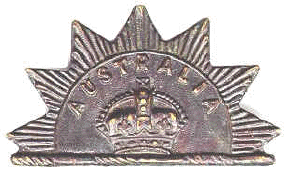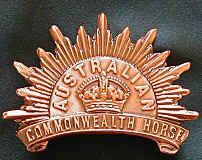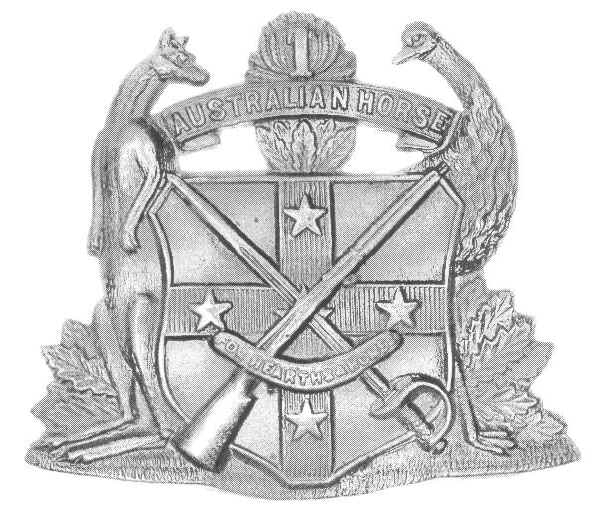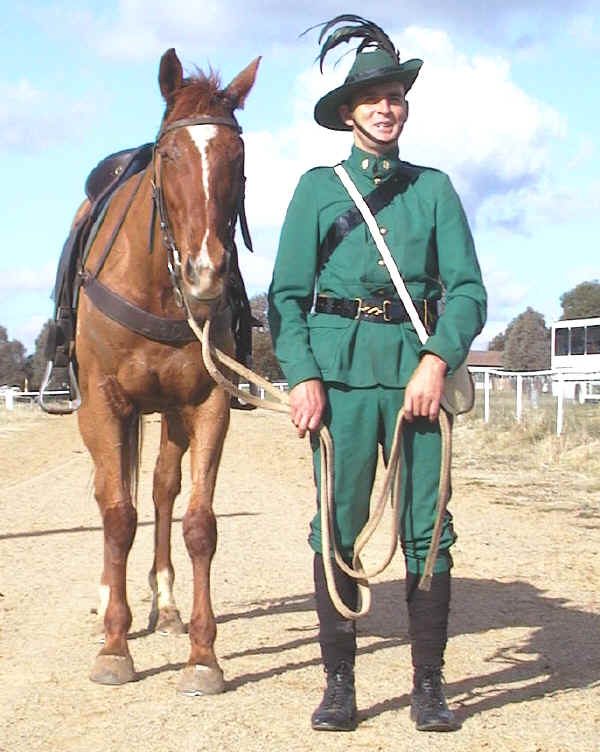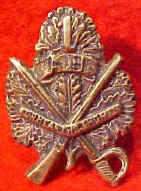 |
|
|||
|
|
||||
|
AUSTRALIAN HORSE "Virtus in Arduis" |
|
|
|
|
| The original Australian Rising Sun | The 2nd version of the Rising Sun |
| Lineage. (Each one is a link) |
|
The 7th/21st Australian Horse, which disbanded in 1957, was successor
to two light horse regiments of the Citizen Military Forces (CMF)- 7th
Light Horse Regiment (Australian Horse) and 21st Light Horse Regiment
(Riverina Horse) and The following are the changes in designation of the above-mentioned light horse regiments of the C.M.F.:
1. Australian Horse, 1898-1921 Approval to raise a cavalry regiment of bush volunteers (unpaid) was gazetted in August 1897 and the actual raising was carried out early in 1898, the name of the regiment being 1st (Volunteer) Australian Horse. The personnel were described by Colonel Mackay in a letter thus: ". . . the men being shearers, station hands, farmers or squatters and the officers, in nearly all cases, sons of old squatter families."
The unit, 402 strong, marched into its first camp at Easter 1898 at Milkman's Hill near Rookwood. The first consignment of their London-made uniforms and accoutrements had arrived in the Port of Sydney earlier in the same week, so the first issue was made in camp. The uniform was myrtle green in colour, of hussar pattern except for the head dress, which was a green slouch hat (see above) Arms were swords and carbines. The first 2nd-in-command was Major Ferguson, 2nd Life Guards, private secretary to the Governor and the first Adjutant was Lt R. R. Thompson, late 4th Dragoon Guards and NSW Lancers. The Governor of New South Wales, Lord Beauchamp, became Honorary Colonel of the Regiment.
In 1900, the 1st Australian Horse was placed on the Partially Paid
establishment and by 1901 the squadron organization was:- The regimental motto was "For hearths and homes". Badges and buttons were brass. The design of the badge was roughly: a shield on which was the badge of the Colony (St George cross carrying the four stars of the Southern Cross); across the face of the shield crossed musket and sword and a boomerang on which was the motto; the shield flanked by supporters, a kangaroo and an emu; centrally above the shield a waratah and across that from supporter to supporter a scroll showing "Australian Horse"; Waratah leaves as background for the legs of the supporters. In October 1899, the establishment was 638 all ranks. When the South African War broke out, the Regiment quickly mobilized a detachment of 34 all ranks under Lt W. V. Dowling, which sailed from Sydney on 13th November, 1899.
The service squadron was engaged almost continually from 7th March until October 1900, where after it returned to New South Wales.
As well as many minor actions, the Australian Horse took part in 41
engagements. Sergeant Major H. Arnold was awarded the DCM. Casualties
included 2 officers and 2 others killed in action and 6 other ranks
died of disease. Headquarters of the 3rd were at Goulburn. The Honorary Colonel was as previously, Earl Beauchamp, K.C.M.G. By 1908, the Regiment's localities had become: Goulburn, Braidwood, Araluen, Bungendore, Michelago, Bredbo, Cooma, Bega, Pambula, Cobargo, Cootamundra, Murrumburrah, Gundagai and Tumut. Establishment was 310 all ranks. For several years, the Regiment continued to use its own green uniforms, both field service and full dress but eventually took into use the standard khaki uniforms with white facings prescribed for the Australian Light Horse. From 1903, all Light Horse Regiments throughout the Commonwealth were to be armed and trained as mounted riflemen and not as cavalry who carry a sword for mounted shock action. Arms were S.M.L.E., .303 inch rifles and bayonets, although in fact the bayonets did not become available for several years. Like the lancer regiments in New South Wales, the 3rd Australian Light Horse Regiment was permitted to retain its swords for ceremonial and tournaments. In 1904, the Regiment received a Banner (erroneously called a King's Colour) in recognition of South African War service. In 1908, Military Order No 123 announced that His Majesty approved of the grant of the Honorary Distinction "South Africa, 1899, 1900" and explained that the Banner is not a King's Colour and that the Honorary Distinction was not to be borne upon it. An affiliation between the six light horse regiments of New South Wales and King Edward's Horse (King's Colonials) was announced in 1908. With the advent of Universal Training in July 1912, there was a re-organization of units, however, the only change for the 3rd was that its designation was altered to 11th Light Horse (Australian Horse). Although it took in a few universal (compulsory) trainees, the bulk of its personnel continued to be voluntarily enlisted. World War One broke out in August 1914. Militia regiments were not sent overseas but fresh Light Horse Regiments were specially raised as part of the Australian Imperial Force to serve in any theatre. The 11th Light Horse, therefore, was drained of many who left to join the A.I.F. and it continued on a part-time basis and before 1918, militia training had tapered off to a minimum as the country's main effort was directed to the manning and equipment of its forces abroad. In 1918 regiments were re-numbered in order to perpetuate the designations, records and traditions gained by the A.I.F. units in the War. The 11th thus was re-numbered 7th so that it would become the successor to the 7th Light Horse Regiment, A.I.F. From the end of the war to March 1921, no militia training of
consequence was carried out. Uniform was Khaki, of AIF pattern; badges used were Commonwealth, black oxidized. The colour patch of 7th Light Horse Regiment, A.I.F. was worn on tunic sleeves; it was rectangular, divided diagonally, the upper portion being black and the lower red, worn with the broad of the red to the front. In time, approval was received for the cavalry to wear plumes in their hats. About 1933, a new pattern of tunic was adopted and maroon became the distinctive facings colour for the light horse. In 1928 a regimental guidon was consecrated at a Brigade camp at Liverpool and presented to the Regiment by Lt Gen Sir Harry Chauvel. Borne on the guidon are the honorary distinction "South Africa, 1899-1902" and the World War One battle honours of 7th Light Horse Regiment, A.I.F. After the suspension of universal training in 1929, units were allowed to wear their own badges again. The 7th used the design of its former collar badge for both hat and collar - crossed musket and sword on a Waratah background, with motto on a boomerang across the intersection of the musket and sword. The alliance with King Edward's Horse lapsed after World War One owing to the disbandment of that unit. It was superseded by one with The Queen's Bays (2nd Dragoon Guards).
In 1936, following re-organization of 1st/21st, the Nowra and Kangaroo
Valley Troops of that unit were absorbed and the 7th became 7th/21st,
raised as follows: However, in 1937, 21st was reformed as a separate regiment, "Riverina Horse" and the Australian Horse reverted to the designation of 7th Light Horse Regiment. After the outbreak of World War Two, once again many of the personnel left to join the A.I.F. and the 7th became part of the Home Defence Force. In 1942 it was converted and redesignated 7th Australian Motor Regiment and was called up for full-time duty. In 1943, it was disbanded, as were a number of other Citizen Force units owing to the drain made on man-power by the A.I.F.
National Service (NS) was introduced in Australia in 1951. This led to the strength of the Regiment being considerably increased due to large intakes of N.S. men: the strength rose from approximately 140 active members (volunteers) in 1950 to approximately 1300, mostly N.S. men, in 1956.
In 1951 the role of the Regiment was changed from reconnaissance to
anti-tank defence. Then, in 1956, there was a major re-organization and thenceforth the unit was raised only in and around Wagga Wagga. It became an Anti-Tank Regiment, R.A.A.C. and was still part of 2nd Division. Its primary equipment was changed from armoured and scout cars to 6-pr anti-tank guns towed by 1-ton trucks.
As from 14th September 1956, 7th/21st Australian Horse was disbanded,
its personnel being absorbed into 4th Battalion and other units.
|
